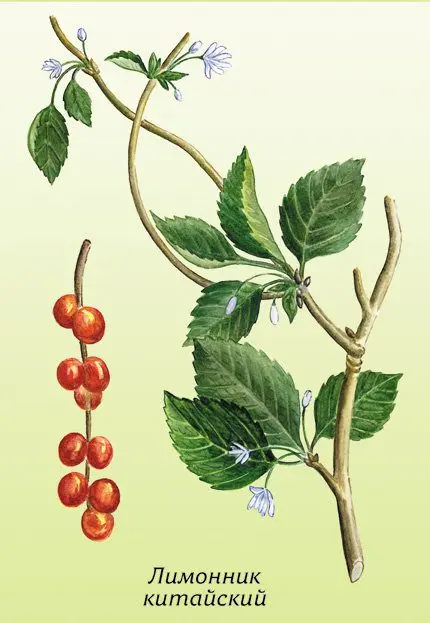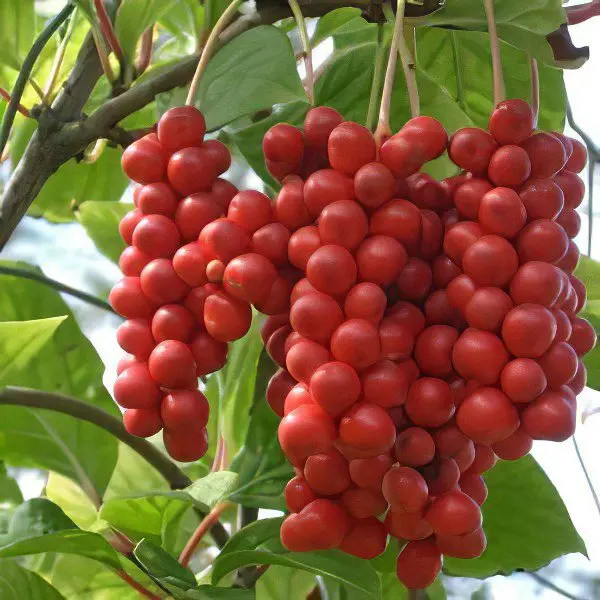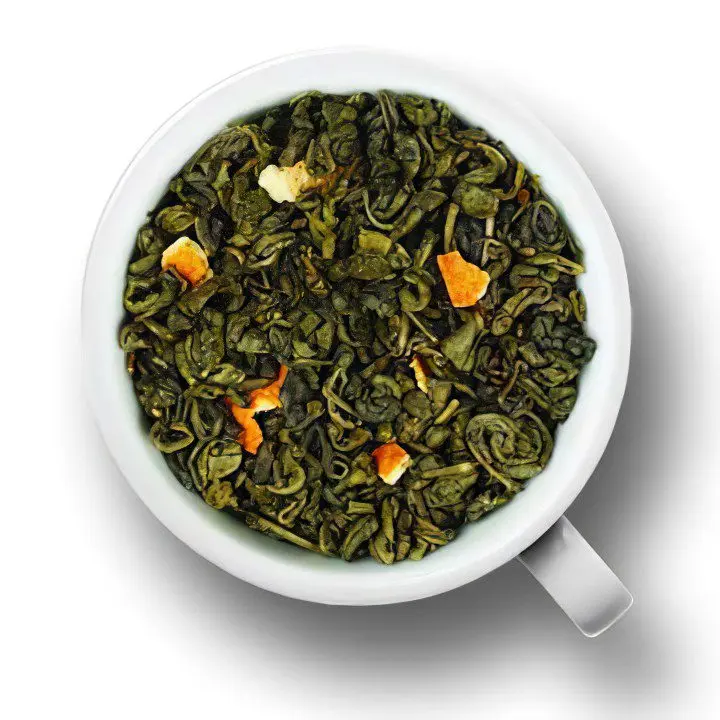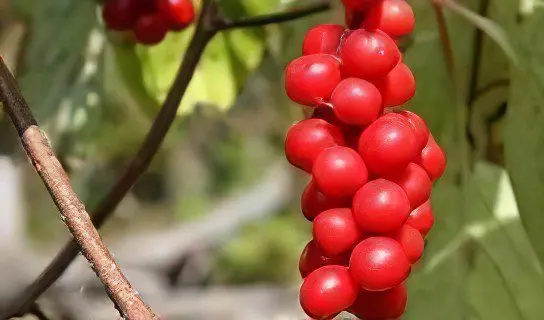Useful properties and recipes for using Chinese lemongrass
Botanical characteristics of Chinese magnolia vine

Schizandra Chinese – This is a perennial, woody, deciduous, climbing vine from the Schisandra family. Also, this plant has many popular names, such as “Chinese schizandra”, “Manchurian lemongrass” and “ts-wei-tzu”, which in Chinese means “berry of five tastes”.
Chinese lemongrass can reach 15 meters in height, wrapping around shrubs and tree trunks. The stalk of lemongrass is wrinkled, branching, 1,5–2 cm thick and has many longitudinal lenticels. The color of the stem depends on the age of the plant. For example, young specimens have a shiny, yellowish bark, while older plants have a dark brown color.
The leaves of Schisandra chinensis are alternate, slightly fleshy and have an elliptical shape with a wedge-shaped base. The color of the leaves is dark green on the upper side, and pale on the lower side. The tops of the leaves are pointed. Petioles are pinkish-red in color and are approximately 2-3 centimeters long.
The flowers of the Chinese lemongrass are located on thin long pedicels, have a white or slightly pink color and a pleasant fragrant aroma. Flowering lasts from early May to mid-June. After flowering of lemongrass, its receptacle grows in such a way that a spike-shaped polyberry brush is formed from the flower, which consists of 20–25 juicy red fruits.
The fruits of Chinese magnolia vine are spherical berries with two shiny kidney-shaped seeds of brown, yellowish or brown color. The taste of fruits is specific, spicy, sour-salty, bitter, sometimes burning. The odor of the berries, as well as of the leaves and stems, is strongly lemony when crushed.
Growing Chinese lemongrass
Chinese magnolia vine has been grown and used for medicinal purposes since 250 BC in ancient China. Later, lemongrass spread throughout the Far East, where the indigenous population often used it as a means of restoring strength.
Schisandra also grows wild in China, Japan, Korea, Sakhalin, Primorsky and Khabarovsk Territories.
Schizandra grows in mountain, broad-leaved, valley and mixed forests. Often lemongrass can be found on the edges, near shrubs, near the valleys of streams and rivers. Chinese magnolia vine loves well-drained, organic-rich, acidic to slightly acidic soils. For medicinal purposes, lemongrass is grown on special plantations.
Growing lemongrass in summer cottages and gardens is not a laborious task, since the liana is an unpretentious plant. It is recommended to plant lemongrass in partial shade, as plants grown in a sunny area do not develop well and do not bear fruit. Watering should be moderate, since lemongrass does not like stagnant water and drying out of the soil. Lemongrass is also a wonderful decoration for the walls of houses, arbors and verandas. When growing lemongrass as a hedge, you need to put strong supports, for this you can use arches, trellises or trellises. Without good support, lemongrass does not bear fruit.
Collection and harvesting of Chinese magnolia vine

Fruits, seeds, leaves and bark of lemongrass are used as medicinal raw materials. The bark is harvested in the spring, the stems – during the fruiting period. In order to obtain flavonoids, the collection of lemongrass leaves is carried out in the phase of their blooming, and preparations for obtaining mucus from the leaves are carried out in the process of leaf fall. It is better to start collecting leaves and shoots in August, cutting off old unproductive vines. Then they should be crushed and laid out in a thin layer. It is necessary to dry raw materials under a canopy, stirring occasionally.
Schisandra chinensis berries should be harvested when they are fully ripe. The ripening period of lemongrass fruits continues from September and lasts until autumn frosts. It is necessary to cut the brushes with berries very carefully, it is better to use a sharp knife for this. Try not to damage the vines, as a plant without support may stop fruiting. As containers for harvested fruits, it is better to use barrels, baskets or enameled dishes. But the use of galvanized buckets will lead to their oxidation due to the juice of the berries. Processing of fruits must be carried out within a day after harvest. Schisandra berries can be harvested in two ways.
1 method: the harvested fruits of Schisandra chinensis must be dried under a canopy in the shade for three days. Then you need to sort out the berries, separating the receptacle, twigs and other impurities from them. After the berries are dried in an oven at a temperature of 60 ° C. Fruits that have undergone such treatment do not lose their medicinal properties for two years.
2 method: lemongrass berries should be pressed on a hydraulic press. Further, after the fermentation process, the fruits on the sieve are washed under running water. Seeds must be separated and dried on caloriferous ventilation dryers. The washed fruits are dried in thermal dryers, first at a temperature of 35-40 ° C, and then dried at a temperature of 60-70 degrees.
Useful properties of Chinese lemongrass
All parts of the Chinese lemongrass have a composition rich in useful substances. Lemongrass fruits contain about 20% organic acids: these are malic, citric and tartaric acids. In addition, the berries have a high content of mineral salts and vitamins C and E. The fruits also contain trace elements such as zinc, copper, iron, manganese, nickel, phosphorus, potassium, sulfur, silver, calcium, molybdenum and titanium. Due to the large amount of tonic substances, lemongrass fruits are able to increase excitation in the human cerebral cortex, and also help to increase the reflex activity of the central nervous system. It is the effect on the central nervous system that causes stimulation of the cardiovascular system and excitation of respiration, providing a tonic and stimulating effect. Dried fruits contain starch, ash, fiber and water-soluble substances.
Lemongrass seeds no less useful. They are believed to contain active ingredients such as schizandrol and schizandrin. The seeds are also rich in fatty oils, anthocyanins, catechins, resinous and tannins. In folk medicine, the use of seeds has become widespread for the treatment of tuberculosis, bronchitis, bronchial asthma, anemia, diseases of the stomach, intestines, liver and kidneys.
Schisandra chinensis leaves are rich in essential oils. Therefore, infusions on the leaves and bark of lemongrass are an effective remedy for the treatment of scurvy and infantile dysentery.
The use of Schisandra chinensis

Schisandra chinensis is a valuable medicinal plant and is cultivated in many countries. Both in scientific and folk medicine, Chinese magnolia vine is used as a powerful tonic for overwork, exhaustion of the nervous system, reduced mental and physical performance, for the healing of trophic ulcers and wounds that do not heal for a long time. Lemongrass contributes to a longer preservation of strength and energy in people engaged in heavy mental or physical labor.
Schisandra has long been successfully used in Chinese folk medicine to treat diseases of the gastrointestinal tract, liver, kidneys, impotence, anemia and bleeding. It is also recommended to use lemongrass in small doses for women during menopause – to relieve excessive irritability and tension.
Lemongrass is able to enhance visual acuity and enhances the ability of the eyes to adapt in the dark. Also, the plant will help people engaged in mental work, as its stimulating substances help increase attention, concentration and wholeness of perception.
Since the berries of Schisandra chinensis are practically inedible fresh, they are often dried, juices, jams and jams are prepared from them. In canning, the juice of lemongrass berries is added as a seasoning for syrups, compotes and jelly. The juice is also used for wine bouquets. And when pickling cucumbers, tomatoes and mushrooms, lemongrass leaves are often added.
Essential oils, which are rich in Chinese lemongrass, are highly valued and often used in perfumery, soap making and cosmetics.
Also, in addition to wide medical use, lemongrass is often grown as an ornamental plant.
Recipes based on Schisandra chinensis
Lemongrass leaf and stem tincture prepared from finely chopped fresh leaves, stems or shoots of Chinese magnolia vine and 70% alcohol in the proportion of 2 tablespoons of raw materials to 6 tablespoons of alcohol. It is better to choose dishes for such a tincture from dark glass. In order for the mixture to infuse, it is necessary to keep it for 10 days in a dark place, after which the tincture is filtered and left in the same bowl. It is best to store the tincture in the refrigerator. This remedy is recommended to be taken on an empty stomach before meals and 5 hours after. The dosage is purely individual and should not exceed 30 drops. the tincture is taken 2-3 times a day. Treatment with tincture of lemongrass on alcohol is best done in courses of 20–25 days.
Tincture of lemon fruits. 40 grams of lemongrass berries should be poured with 50% ethyl alcohol, given the ratio of 1:5. The mixture should be infused in a dark place for 10 days. Then the tincture must be filtered, and another 20 ml of alcohol should be added to the resulting precipitate and insisted for 10 days. Next, both tinctures must be combined and mixed with an equal volume of distilled water. Take this tincture should be 2-3 times a day, 2,5 ml before meals. The recommended course of treatment is 14 days. The tincture helps with dizziness, sleep disturbances, frequent headaches, depressive and asthenic syndromes.
Lemongrass seed tincture. For its manufacture, you will need 10 grams of crushed lemongrass seeds, 20 grams of its berries and 70% alcohol. Seeds and berries are poured into 100 ml of alcohol and left to infuse in a dark glass container at room temperature for 10 days. Then the resulting tincture must be filtered. It should be consumed on an empty stomach, adding 20-30 drops to water. It is recommended to take the remedy for anemia, general fatigue, fatigue, sexual weakness, stomach diseases, colds and nervous diseases. Often tincture is used to prevent influenza. In Korean medicine, lemongrass seed tincture is used to speed up and stimulate labor: 3-4 times with an interval of one hour.
Lemon juice made from freshly picked, washed and pressed berries. The resulting juice must be poured into pasteurized glass jars and pasteurized for 10-15 minutes. Then the container should be hermetically sealed. This juice increases efficiency and raises vitality. You need to drink juice with tea – in the proportion of one teaspoon per cup of tea.
You can also make sweetened lemongrass juice. To do this, it is necessary to add sugar to the juice squeezed from the fruit: for one liter of juice from lemongrass berries – one kilogram of sugar. The mixture must be put on low heat and, stirring, bring to complete dissolution of sugar. After dissolution, the juice should be heated to 90 ° C, poured into pre-sterilized jars and rolled up.
Tea. To brew tea, you will need dried leaves, bark or young shoots of Chinese magnolia vine. Approximately 10-15 grams of raw materials are poured with a liter of boiling water and, without interfering, insist 3-4 minutes. Lemongrass leaves can also be added to regular tea. It is not recommended to brew tea in a thermos, this will deprive it of aroma. Regular consumption of tea with the addition of Chinese lemongrass strengthens the immune system and increases resistance to colds.
Lemongrass seed powder. To make it, you need to pour lemongrass fruits with water and leave for several hours, after that, separating the pulp, get the seeds. They should be dried well in the oven, then ground into powder. Seed powder is used in acute and chronic hepatitis as a liver-protecting agent, after prolonged illnesses, and as a tonic and stimulant for physical and mental fatigue. Take the powder should be 0,5 grams 2 times a day before meals.
The stimulating effect of Schisandra chinensis occurs 30 minutes after consumption and lasts for six hours.
Contraindications to the use of Schisandra chinensis

Since Chinese magnolia vine is one of the strongest natural stimulants, its use is contraindicated in arterial hypertension, cardiac disorders, epilepsy, irritability, sleep disturbance, increased intracranial pressure, overexcitation, arachnoencephalitis, arachnoiditis, chronic liver diseases and acute infectious diseases.
It is also necessary to refrain from using products containing lemongrass for pregnant women, women during lactation, people with vegetative-vascular dystonia and children under 12 years old.
To avoid insomnia, you should not take preparations containing lemongrass in the afternoon.
Side effects of lemongrass: tachycardia, increased secretion of the stomach, insomnia, headache, allergic reactions and increased blood pressure. Treatment with Chinese magnolia vine should be carried out under medical supervision and only after a preliminary examination.









